Mark Morris Dance Group / BAM Howard Gilman Opera House, Brooklyn, NY / February 23-27, 2010
Imagine a dance so cool, calm, and exquisite, it seems unreal–a vision from some empyrean realm.
The music, deliberately free from dramatic emphasis, is Eric Satie’s 1918 three-part Socrate, in the version for piano and voice, here with Colin Fowler at the keyboard and the tenor Jean-Paul Fouchécourt singing–almost as if he were speaking dispassionately–the text derived from Plato’s dialogues. The dance, a perfect echo of the score’s subtlety and purity, is Mark Morris’s Socrates, given its world premiere in the Mark Morris Dance Group’s performances at the BAM Howard Gillman Opera House March 23-27.
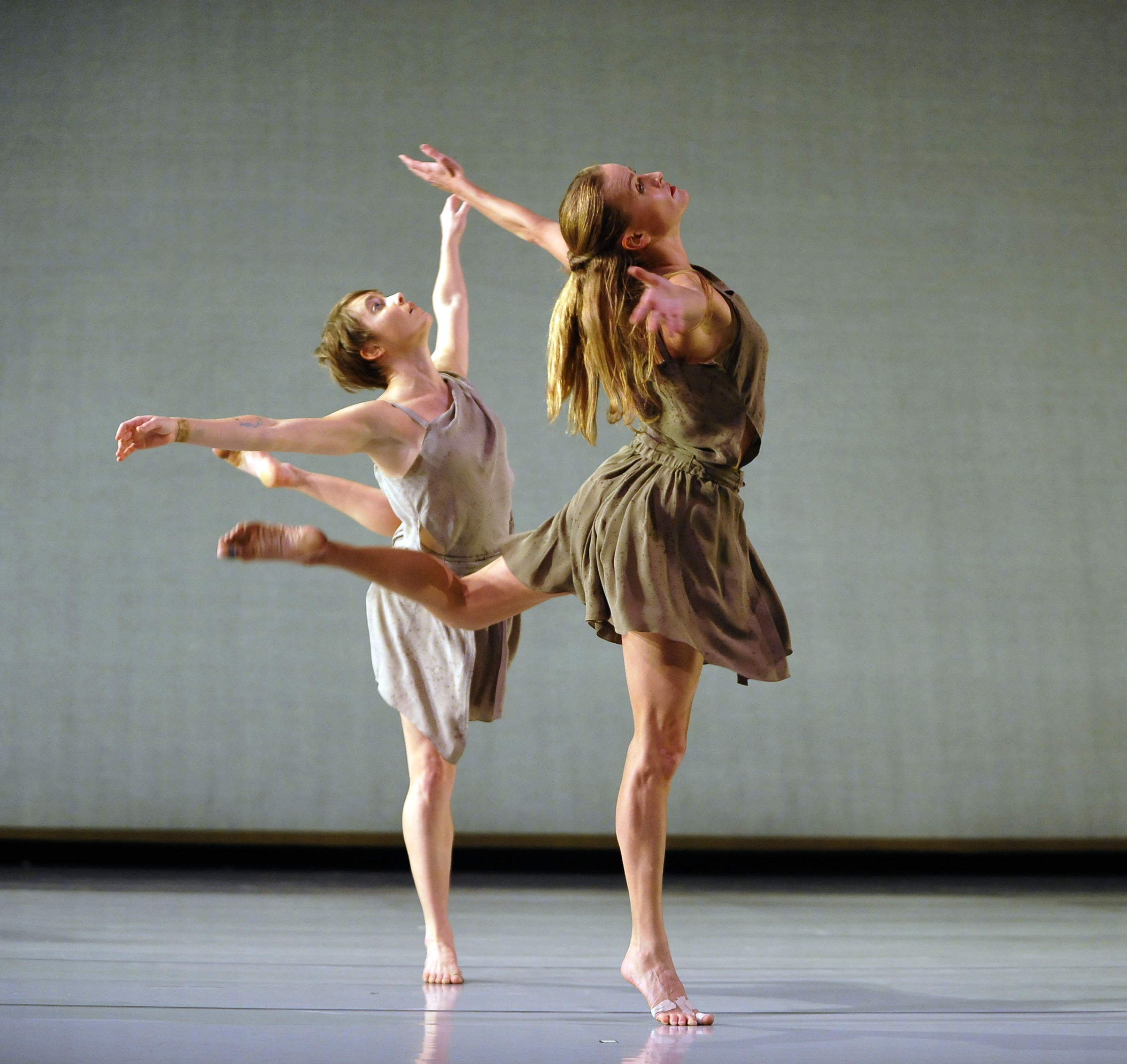
Elisa Clark and Julie Worden in Mark Morris’s new Socrates
Photo: Stephanie Berger
Morris had engaged with this music before, in 1983, using its final section which recounts, with uncanny restraint, the death of the philosopher. (Socrates, found guilty and imprisoned by his government for promulgating ideas that threatened the status quo, is sentenced to drink a fatal poison. He complies with an uncanny fortitude, as if he were simply taking the next step in his life.) Nearly three decades ago, Morris made a somber, slow-motion piece for six men that I’ve never forgotten, though I saw it only on a grainy black-and-white videotape. The new piece, to the full score, reminds me of the older one, as if it had gone through a very long gestation to emerge as the work of a mature artist whose skills and imagination are at their height.
Not unexpectedly, Morris’s choreography for that last section of the score, “The Death of Socrates,” is the most fulfilling part of the new work; it’s bound to make even the most restrained viewer weep. Here, as the fleet dancers cross the stage laterally again and again, you sense the flow of human experience (individual and communal at once) and see how mimed gestures–often bluntly literal ones–surge through the matrix of abstract dance. From the early days of his career, Morris has been deft at marrying prose and poetry, gestures that tell a story and dance for dance’s sake.
With a masterly hand, Morris conveys the belief that what happens to one, happens to everyone: Socrates is “played” by one dancer and then another and another. Elsewhere, small groups, often quartets and quintets, illustrate a single event. At the end, the entire ensemble of 15 dies Socrates’ death–one body after another succumbs without struggle to the numbing hemlock, each with the same sequence of brief phrases, multiplying the effect of the tremendous moment through merciless repetition, the way traumatic events may echo remorselessly in our minds.
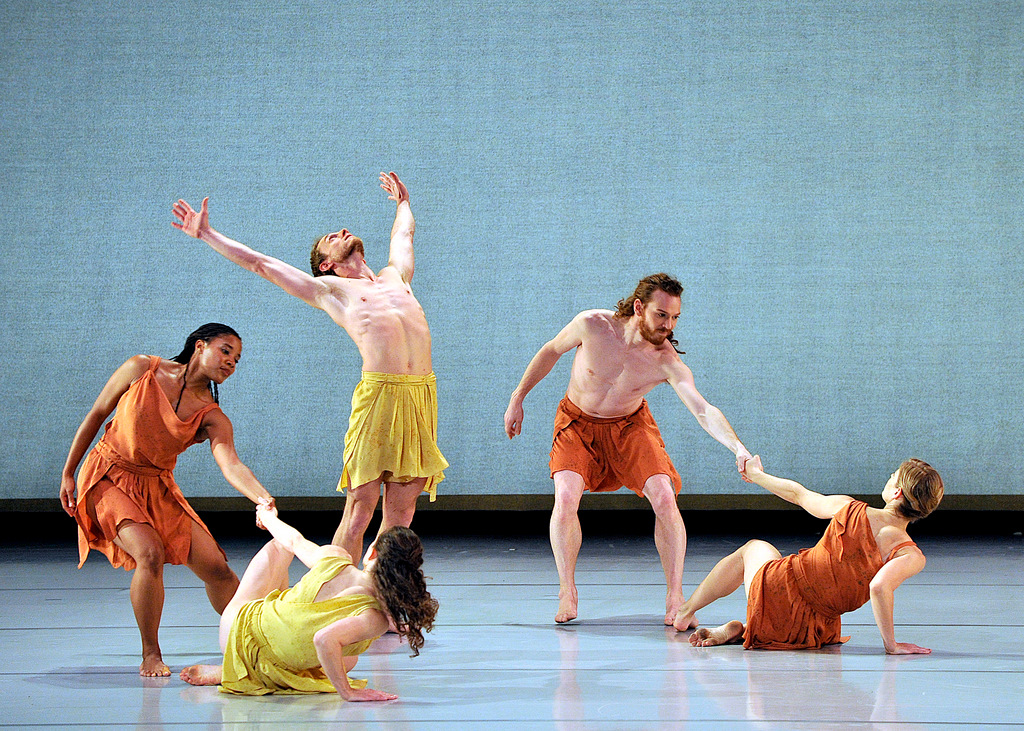
The Mark Morris Dance Group in Socrates
Photo: Gene Schiavone
The opening section, “Portrait of Socrates,” immediately establishes the ancient-Greece setting through Martin Pakledinaz’s lovely costumes–variations on a theme of the Greek chiton, echoing in pastel hues the palette Jacques-Louis David used for his celebrated picture, The Death of Socrates, and with a single male figure positioned in an upstage corner against a column of light, semi-reclining as we’ve learned to imagine the disciples who listened to the great Athenian philosopher’s arguments. The most striking element in the dancing is done in duet form and suggests folk style, with the couples linked by a knotted rope held by each pair. A diminutive, frail-looking woman weaves her way through the scene alone; her lack of a partner and the addition of an unobtrusive train to her costume suggests she represents Socrates’ wife, Xanthippe, anticipating her bereavement.
The middle section, On the banks of the Ilissus, illustrates, with just a touch of irony, Socrates’ method of gentle but persistent questioning to enable another person to get his mind around a particular way of thinking. It is also a pastoral idyll, in which small groups of dancers moving lyrically through the space evoke the landscape the singer describes: a river fed by cool tributary streams, welcome shade trees, fragrant blossoms, chirping crickets, and carpets of grass inviting cushioned repose.
And then we come to the calm, plainspoken account of Socrates’ death, which rips your heart out.
The revival of Morris’s 1990 Behemoth, the sole ballet by the most musical–indeed, music-driven–of choreographers that is accompanied only by silence, was met with breath-held silence by the audience–except for the few who turned their backs on the stage and stalked out, in good old modern-dance tradition. Considered in retrospect, it suffered from being on the same program with Socrates because both dances are strictly objective, the dancers deliberately shorn of individual personality, and both emphasize the kind of clear, shifting, intricate patterning that is a Morris specialty. Otherwise, as far as I’m concerned, Behemoth is terrific; it’s been one of my favorite Morris dances since I first saw it.
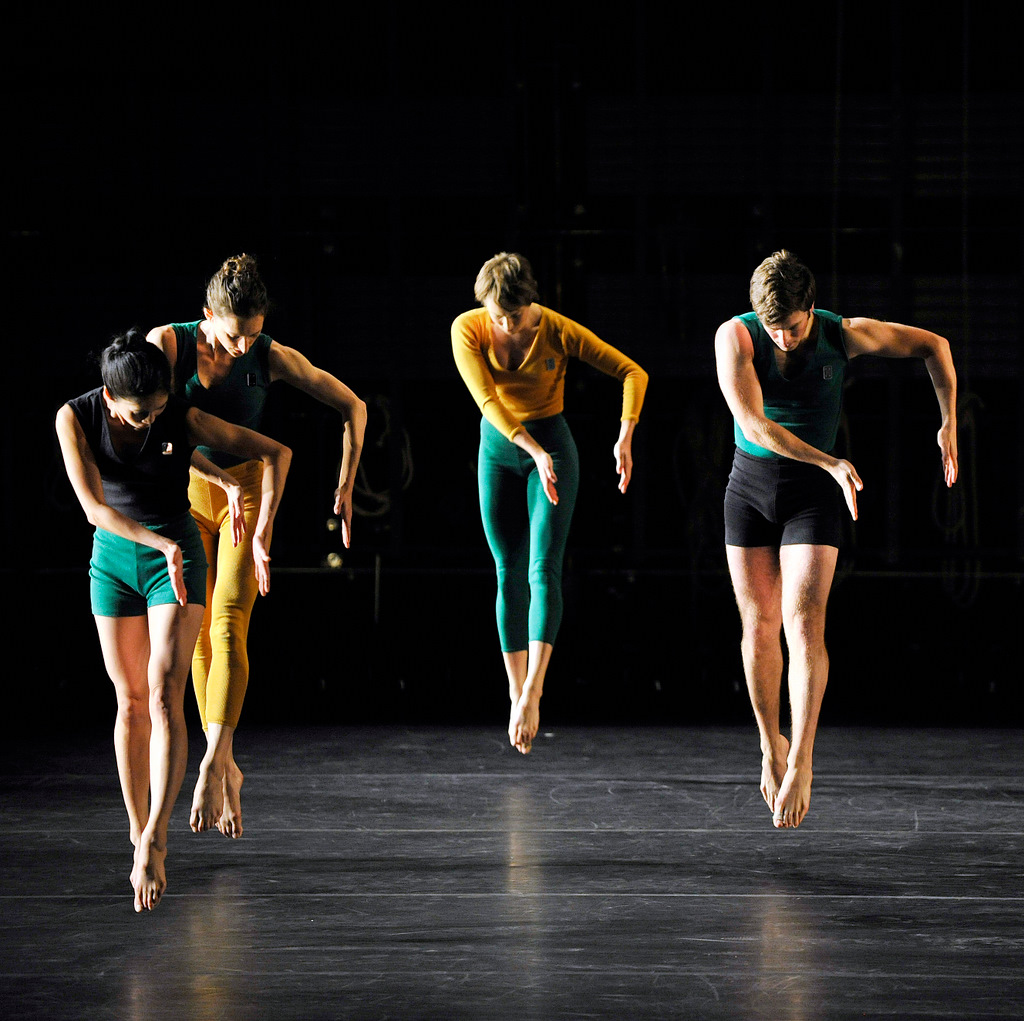
The Mark Morris Dance Group in Behemoth
Photo: Gene Schiavone
The scene is a denuded stage. With its towering empty space above and its raw edges left in murky darkness, it might be a metaphor for a prison. Separated by blackouts, the segments of the 40-minute dance are uneven in length, as if to catch the viewer unawares or dislocate his sense of time–a device almost as powerful as the pervading silence.
When the dancers move–at first still rooted to their “assigned” spots–they continue to be held in thrall by a severely limited vocabulary of steps and postures, and even these actions are interspersed with foreboding moments of stillness. From time to time they shudder, wriggle their fingers in the air so that their hands look like spiders in their death throes, or sound a single clap with hands drawn prayerfully to their breasts. The noise is, of course, startling. The claps might be urgent signals–but of what? To whom? The ambiguity is in itself menacing.
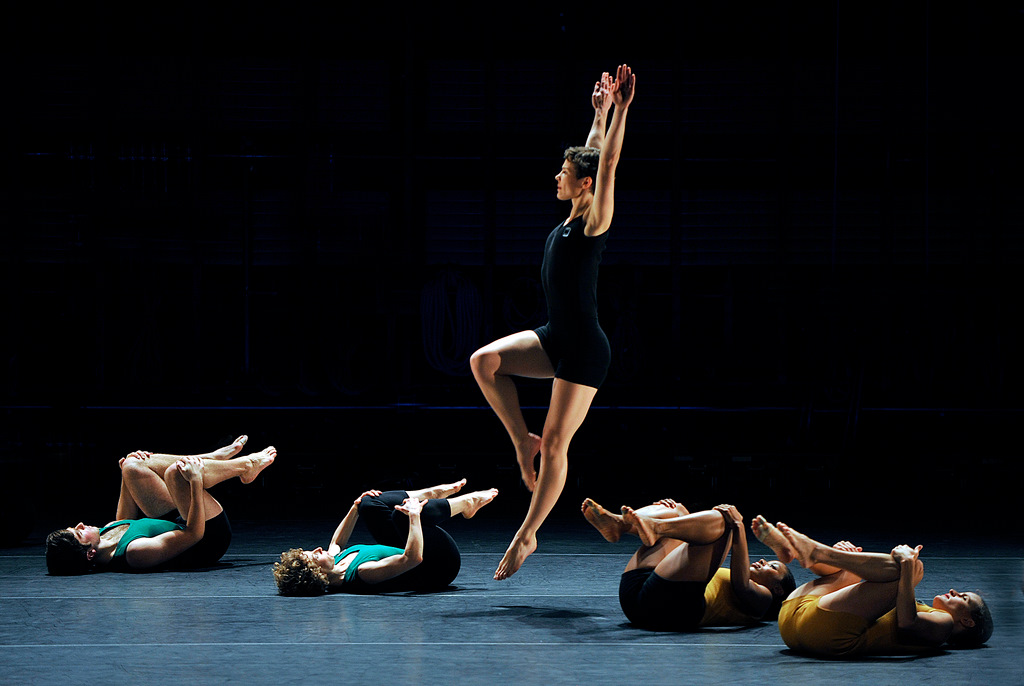
The Mark Morris Dance Group in Behemoth
Photo: Gene Schiavone
Most often the bodies move in unison, sometimes all at once, more often in small groups. Occasionally one dancer is singled out. But before you can mark him or her as the leader of the assembled figures, he/she’s replaced by another. And then another. What’s more, even the bodies moving alone appear to be part of an unholy system.
There is some partnering, but it has nothing to do with love or even lust. There is plenty of falling, the bodies delivered to the floor like rag dolls hurled by an angry child. There are ghosts, dimly visible figures that hover in the wings as if to go on stage, but then retreat. Throughout, Morris is ingenious in configuring his pared-down material so that it rivets the spectator’s eyes and keeps the mind clicking away simultaneously.
Until this revival, I’d thought Behemoth had a 1984 scenario, its figures the victims of a totalitarian system controlling and curtailing their every move. This time, I thought, What if they’re not the victims of a behemoth, but the behemoth itself? “Something enormous in size or power,” says my dictionary.
I can’t say much about Morris’s 2007 Looky, which completed the program, because I just didn’t “get it.” It was the program’s single blithe note, and welcome as such, but I found it confused in both structure and purpose and nowhere near as funny as the choreographer and his dancers meant it to be.
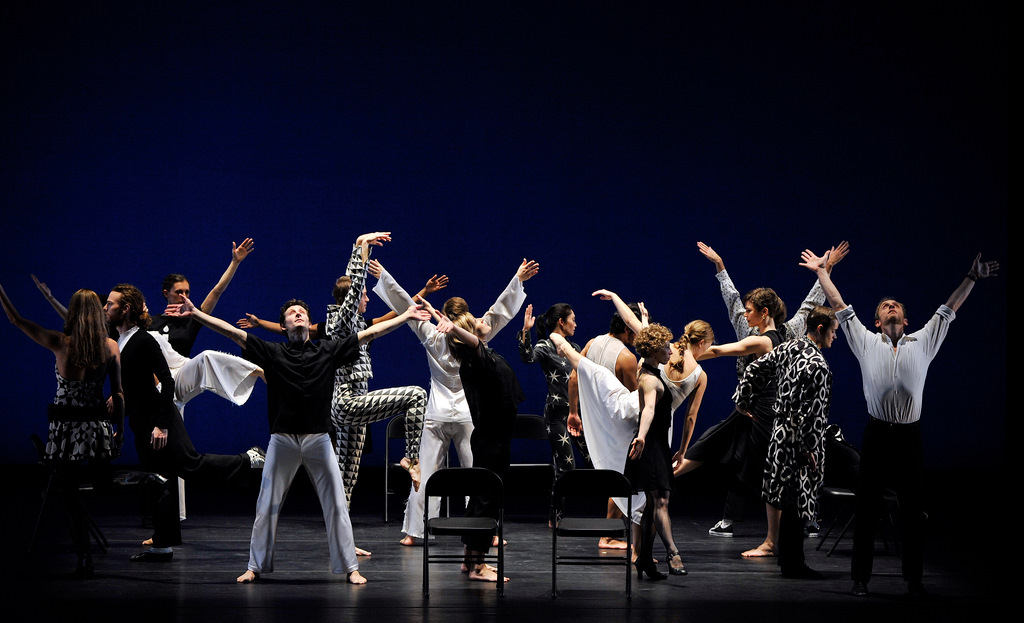
The Mark Morris Dance Group in Looky
Photo: Gene Schiavone
The general idea of the piece, rakishly costumed in black-and-white borrowings from the company’s other works, is to show the postures and pursuits of museum- and gallery-goers. (Paul Taylor has easily–and poignantly–trumped Morris at this sort of game several times over.) Morris settles for puerile slapstick in his finale, having Looky‘s oglers morph into art works themselves, wreaking revenge on an innocent spectator. But in between the crowd (18 strong) succumbs to entertainment. Since the openings of art exhibitions routinely include a glass of whatever, Looky pushes the custom further and segues into two scenes that mix performance with observation and meld in memory as a raucous party: dancing in modes that range from sylphidian ballet to ragtime, drink, recreational drugs, arguing and laughing, mildly licentious behavior, flying folding chairs. And yes, Virginia, Looky is a piano ballet. The instrument in question, duly onstage, is a Disklavier–a digitally fueled player piano–programmed with rambunctious tunes in devilish rhythms by Kyle Gann. That music is the freshest part of the undertaking.
© 2010 Tobi Tobias




As always, Tobi Tobias is an eloquent reviewer and enabled me to see the performance with her words. I was unable to be there, but her review was second best to being there. Thank you, Ms. Tobias! I envy all who were able to attend.
What a glorious review, well-written and so well-deserved!
I’m booked to see this program tomorrow, and after Tobi’s and Alastair Macaulay’s gorgeous appreciations of “Socrates,” I can’t wait! It may include the first positive portrait of Xanthippe in the history of world culture. (Socrates, himself, had nothing good to say about her, and some wits have suggested that he took the hemlock readily as a preferred option to going home.)
I agree of course with Angela Halas about TT’s eloquence and skill as a critic and writer and would add that the honesty and integrity of her response to every work on the program are something all of us who ply this trade should bear in mind. I too found the grainy black and white film of the early “Socrates” memorable and I wish I could see what sounds like a summary work–folk motifs included, long a hallmark of Morris’s choreography. Choreographers often are either musically or visually gifted, seldom equally talented at both. When Morris misses, he misses, but when his work encompasses both, (“Dido and Aeneas,” ” Platee,” and the lighthearted “Dancing Honeymoon” come to mind), nothing gives a more satisfying theatrical experience.
Terrific review. The description of “Socrates” was perfect–and I can say this because I was there! But you added so much to what I saw.
Thanks for writing, Mindy. Actually, Xanthippe made a favorable impression on several distinguished people back in Ancient Greece, even her husband. Have a look at this:
http://en.wikipedia.org/wiki/Xanthippe#Character.
t
Just read the Wikipedia entry on Xanthippe. She had a crush on Plato??!! Whoa, Baby!
The “h” must be for horse, yes? That’s what “Xanthippe” means: “blonde horse.” And I see that she did stampede over a cake. . . .
Now and then I’ll stumble across a post like this and I’ll recall that there really are still interesting pages on the web.